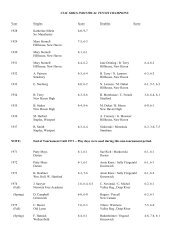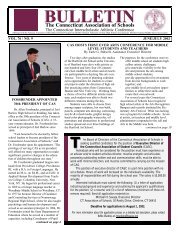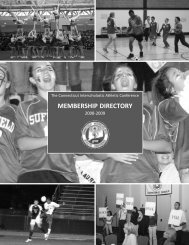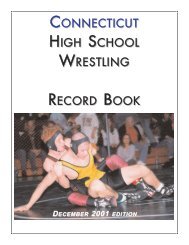BULLETIN BULLETIN - www.casciac.org!!
BULLETIN BULLETIN - www.casciac.org!!
BULLETIN BULLETIN - www.casciac.org!!
Create successful ePaper yourself
Turn your PDF publications into a flip-book with our unique Google optimized e-Paper software.
4<br />
CAS Bulletin<br />
O High school students who take the SAT II<br />
subject tests required for admission to many<br />
colleges soon will no longer be able to<br />
choose which scores the colleges see. Officials<br />
of the College Board have announced<br />
that they will be dropping the score-choice<br />
option that thousands of college-bound students<br />
use each year, because it wastes the<br />
time of high school counselors and collegeadmissions<br />
officers and gives affluent students<br />
an unfair advantage. Under the 9-yearold<br />
policy, the officials say, students who can<br />
afford the cost and have received better academic<br />
guidance—whether at home or in<br />
school—are able to take the SAT II multiple<br />
times in an effort to get better scores. Students<br />
who are less well-off don't enjoy that<br />
advantage. The new policy will likely take<br />
effect next school year. Students taking SAT<br />
II subject exams this year will still have the<br />
option of withholding scores. (Education<br />
Week, March 6, 2002)<br />
*****<br />
O Many states now offer signing bonuses,<br />
relocation expenses, housing subsidies, and<br />
other perks to entice teachers to work in difficult<br />
schools, but a new study has found little<br />
research on the impact of such incentive programs—and<br />
some evidence suggesting the<br />
programs are not meeting their goals.<br />
Released by the Southeast Center for Teaching<br />
Quality, based at the University of North<br />
Carolina at Chapel Hill, the policy brief suggests<br />
that more than money will be needed to<br />
attract and retain teachers in hard-to-staff<br />
schools. It recommends that states provide<br />
scholarships to prepare out-of-field teachers<br />
and paraprofessionals who already work in<br />
such schools to serve as fully licensed teachers;<br />
recruit accomplished teachers to lead<br />
reform efforts in certain schools; and improve<br />
working conditions and school building leadership<br />
in those schools. (Education Week,<br />
March 6, 2002)<br />
*****<br />
O You can now receive free email<br />
announcements on new elementary<br />
and secondary education<br />
publications from agencies of the<br />
U.S. government. New titles by<br />
Topic E-mail Alert Service, a new<br />
program from the U.S. Government<br />
Printing Office, offers timely<br />
notifications on the latest education<br />
titles as soon as they are<br />
available for purchase. Education<br />
publications include:<br />
P Educational research<br />
P Technology in education<br />
P Statistical reports<br />
P Directories of public<br />
schools and education agencies<br />
national news & notes<br />
P Equality and achievement<br />
P Community in education<br />
P Teaching materials and training guides.<br />
To find out about this valuable new service,<br />
visit http://bookstore.gpo.gov/alertservice.html.<br />
*****<br />
O Experts at a recent national forum on<br />
school violence recommended class-size<br />
reduction as an important strategy for reducing<br />
violence. They warned schools against<br />
using excessive security measures, such as<br />
metal detectors, saying that they only create<br />
challenges for violent students. Administrators<br />
should instead use funding to reduce<br />
class size, so teachers can get to know each<br />
of their students and help prevent them from<br />
feeling alienated.<br />
*****<br />
O The FBI has released a report to help<br />
schools assess the seriousness of violent<br />
threats. The report presents a "four-pronged"<br />
assessment model for evaluating whether a<br />
threat is likely to be carried out. This innova -<br />
tive model is based on the "totality of the circumstances"<br />
known about the student in four<br />
major areas: (1) personality of the students;<br />
(2) family dynamics: (3) school dynamics<br />
and student's role in them: and (4) social<br />
dynamics. The report provides details on how<br />
to assess the threat itself as well as the indi -<br />
vidual who has made the threat. While the<br />
report maintains that "there is no profile of a<br />
school shooter," it lists characteristics that<br />
might be exhibited by violence-prone students.<br />
The report can be downloaded at<br />
<strong>www</strong>.fbi.gov/publications/school/school2.pdf.<br />
*****<br />
O After murder and accidents, suicide is<br />
cited as the third leading cause of death for<br />
people between the ages of 15 and 24. It is<br />
estimated that 10% to 15% of all adolescents<br />
attempt suicide. In the United States there<br />
have been many legal cases concerning a stu-<br />
“I certainly have given it a great deal of thought and my answer is<br />
still ‘tails’. . .I mean no.”<br />
dent's suicide that have involved educators,<br />
including school counselors, teachers, administrators,<br />
and school boards. "Suicide Prevention<br />
in Schools: Court Cases and Implications<br />
for Principals," which appeared in the March<br />
issue of NASSP's Bulletin, presents an overview<br />
of cases which should help to clarify<br />
some of the legal issues of which educators<br />
should be aware in relation to suicide. The<br />
article can be accessed at http://<strong>www</strong>.principals.<strong>org</strong>/news/bltn_suicide0302.html.<br />
*****<br />
O Scholastic Inc., the New York City-based<br />
educational publisher, has launched a technology-oriented<br />
quarterly magazine aimed at<br />
school administrators, technology directors,<br />
principals, and business managers. The first<br />
issue of Scholastic Administr@tor—for winter<br />
2002—features stories on school technology<br />
planning, professional-development<br />
strategies, and wireless computing, among<br />
other topics. Scholastic Administr@tor gives<br />
practical, hands-on information on a subject<br />
that's becoming more important for school<br />
leaders, said Lars Kongshem, the senior editor<br />
of the publication. "Technology has<br />
become essential to both the instructional and<br />
administrative side [of education], so school<br />
administrators need ... a high- level view of<br />
technology." Information about obtaining<br />
copies of the new magazine is available<br />
online at <strong>www</strong>.scholastic.com/administrator/.<br />
*****<br />
O Pregnant women who drink alcohol and<br />
smoke may more than double their child's<br />
risk of developing attention-deficit/hyperactivity<br />
disorder (ADHD), according to a new<br />
report. A team of researchers from Harvard<br />
Medical School evaluated the medical<br />
records of 280 children diagnosed with<br />
ADHD whose mothers were interviewed<br />
about lifestyle habits, including smoking and<br />
drinking alcohol during their pregnancy.<br />
These children were compared<br />
with another group of 242 children<br />
without ADHD. The<br />
investigators found that, compared<br />
with non-ADHD subjects,<br />
children diagnosed with<br />
ADHD were 2.1 times more<br />
likely to have been exposed to<br />
cigarettes and 2.5 times more<br />
likely to have been exposed to<br />
alcohol in utero. Previous studies<br />
have found similar associations.<br />
"If further studies of this<br />
association uncover mechanisms<br />
that lead to ADHD in<br />
children, it may be possible to<br />
develop more efficient clinical<br />
interventions," the report concludes.<br />
(Reuters Health, Mar 27)









